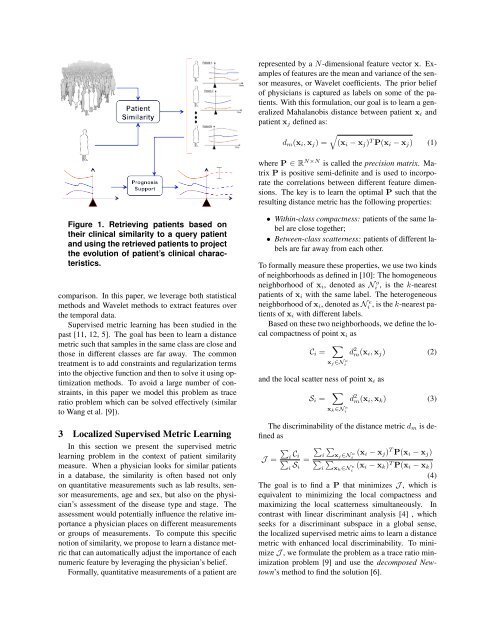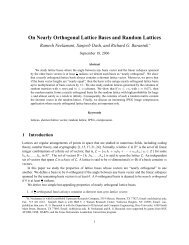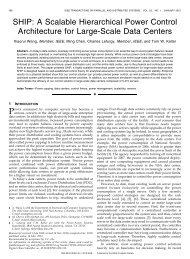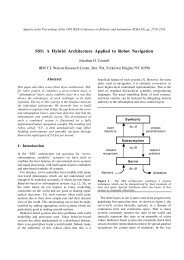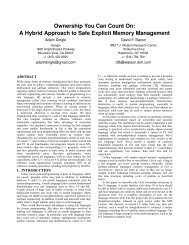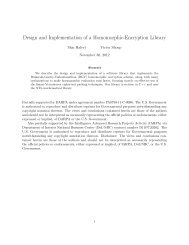Localized Supervised Metric Learning on ... - Researcher - IBM
Localized Supervised Metric Learning on ... - Researcher - IBM
Localized Supervised Metric Learning on ... - Researcher - IBM
Create successful ePaper yourself
Turn your PDF publications into a flip-book with our unique Google optimized e-Paper software.
epresented by a N-dimensi<strong>on</strong>al feature vector x. Examples<br />
of features are the mean and variance of the sensor<br />
measures, or Wavelet coefficients. The prior belief<br />
of physicians is captured as labels <strong>on</strong> some of the patients.<br />
With this formulati<strong>on</strong>, our goal is to learn a generalized<br />
Mahalanobis distance between patient x i and<br />
patient x j defined as:<br />
√<br />
d m (x i , x j ) = (x i − x j ) T P(x i − x j ) (1)<br />
where P ∈ R N×N is called the precisi<strong>on</strong> matrix. Matrix<br />
P is positive semi-definite and is used to incorporate<br />
the correlati<strong>on</strong>s between different feature dimensi<strong>on</strong>s.<br />
The key is to learn the optimal P such that the<br />
resulting distance metric has the following properties:<br />
Figure 1. Retrieving patients based <strong>on</strong><br />
their clinical similarity to a query patient<br />
and using the retrieved patients to project<br />
the evoluti<strong>on</strong> of patient’s clinical characteristics.<br />
comparis<strong>on</strong>. In this paper, we leverage both statistical<br />
methods and Wavelet methods to extract features over<br />
the temporal data.<br />
<str<strong>on</strong>g>Supervised</str<strong>on</strong>g> metric learning has been studied in the<br />
past [11, 12, 5]. The goal has been to learn a distance<br />
metric such that samples in the same class are close and<br />
those in different classes are far away. The comm<strong>on</strong><br />
treatment is to add c<strong>on</strong>straints and regularizati<strong>on</strong> terms<br />
into the objective functi<strong>on</strong> and then to solve it using optimizati<strong>on</strong><br />
methods. To avoid a large number of c<strong>on</strong>straints,<br />
in this paper we model this problem as trace<br />
ratio problem which can be solved effectively (similar<br />
to Wang et al. [9]).<br />
3 <str<strong>on</strong>g>Localized</str<strong>on</strong>g> <str<strong>on</strong>g>Supervised</str<strong>on</strong>g> <str<strong>on</strong>g>Metric</str<strong>on</strong>g> <str<strong>on</strong>g>Learning</str<strong>on</strong>g><br />
In this secti<strong>on</strong> we present the supervised metric<br />
learning problem in the c<strong>on</strong>text of patient similarity<br />
measure. When a physician looks for similar patients<br />
in a database, the similarity is often based not <strong>on</strong>ly<br />
<strong>on</strong> quantitative measurements such as lab results, sensor<br />
measurements, age and sex, but also <strong>on</strong> the physician’s<br />
assessment of the disease type and stage. The<br />
assessment would potentially influence the relative importance<br />
a physician places <strong>on</strong> different measurements<br />
or groups of measurements. To compute this specific<br />
noti<strong>on</strong> of similarity, we propose to learn a distance metric<br />
that can automatically adjust the importance of each<br />
numeric feature by leveraging the physician’s belief.<br />
Formally, quantitative measurements of a patient are<br />
• Within-class compactness: patients of the same label<br />
are close together;<br />
• Between-class scatterness: patients of different labels<br />
are far away from each other.<br />
To formally measure these properties, we use two kinds<br />
of neighborhoods as defined in [10]: The homogeneous<br />
neighborhood of x i , denoted as Ni o , is the k-nearest<br />
patients of x i with the same label. The heterogeneous<br />
neighborhood of x i , denoted as Ni e , is the k-nearest patients<br />
of x i with different labels.<br />
Based <strong>on</strong> these two neighborhoods, we define the local<br />
compactness of point x i as<br />
C i =<br />
∑<br />
d 2 m(x i , x j ) (2)<br />
x j∈N o i<br />
and the local scatter ness of point x i as<br />
S i =<br />
∑<br />
x k ∈N e i<br />
d 2 m(x i , x k ) (3)<br />
The discriminability of the distance metric d m is defined<br />
as<br />
∑<br />
J = ∑ i C ∑ ∑<br />
i i x j∈N<br />
(x<br />
i<br />
i S =<br />
o i − x j ) T P(x i − x j )<br />
∑ ∑<br />
i i x k ∈N<br />
(x<br />
i<br />
e i − x k ) T P(x i − x k )<br />
(4)<br />
The goal is to find a P that minimizes J , which is<br />
equivalent to minimizing the local compactness and<br />
maximizing the local scatterness simultaneously. In<br />
c<strong>on</strong>trast with linear discriminant analysis [4] , which<br />
seeks for a discriminant subspace in a global sense,<br />
the localized supervised metric aims to learn a distance<br />
metric with enhanced local discriminability. To minimize<br />
J , we formulate the problem as a trace ratio minimizati<strong>on</strong><br />
problem [9] and use the decomposed Newtown’s<br />
method to find the soluti<strong>on</strong> [6].


